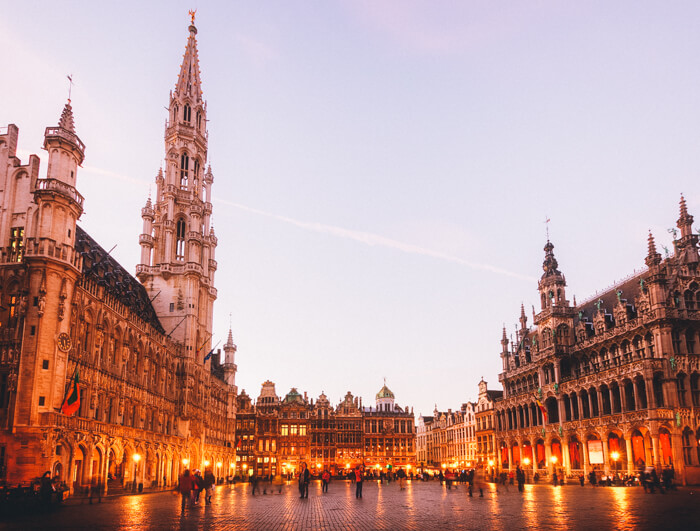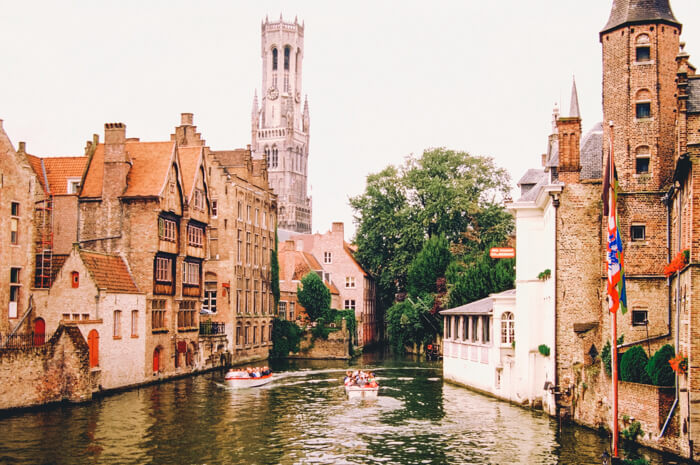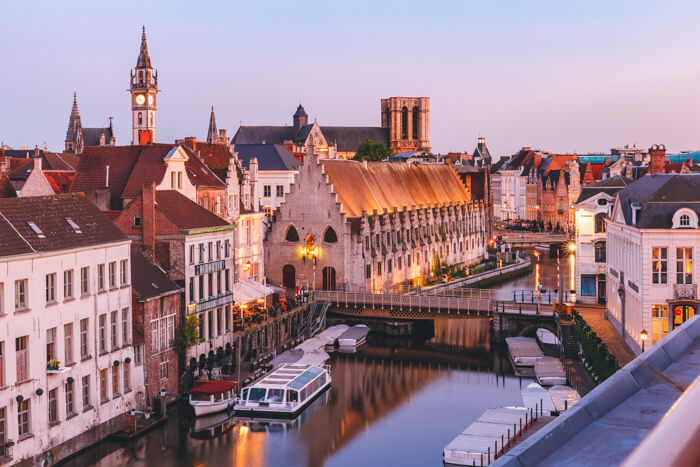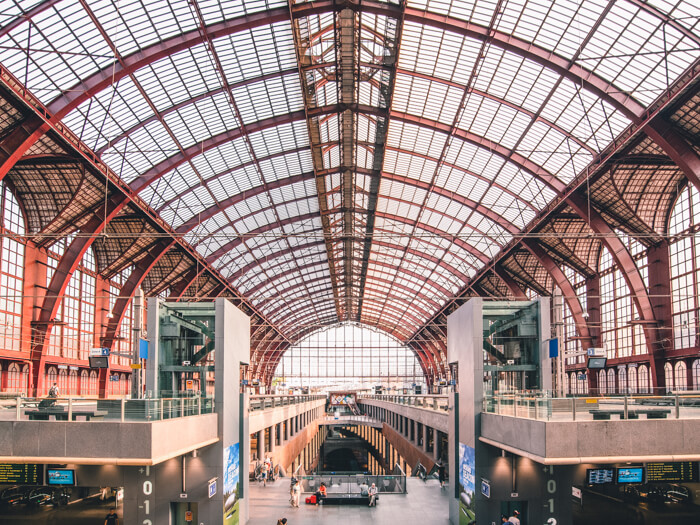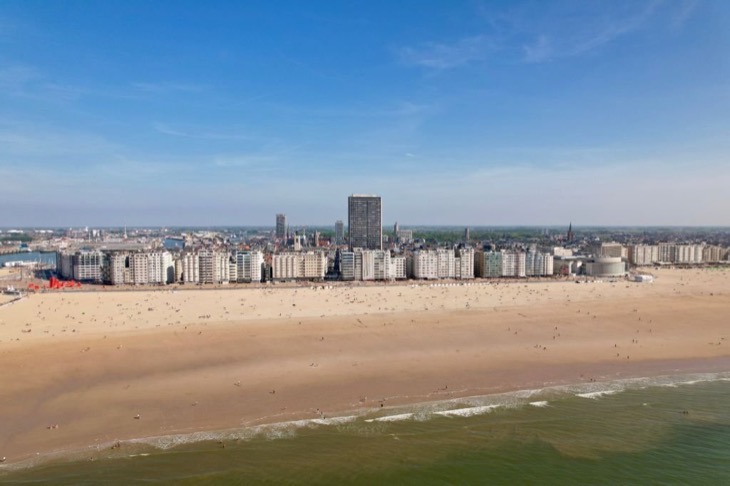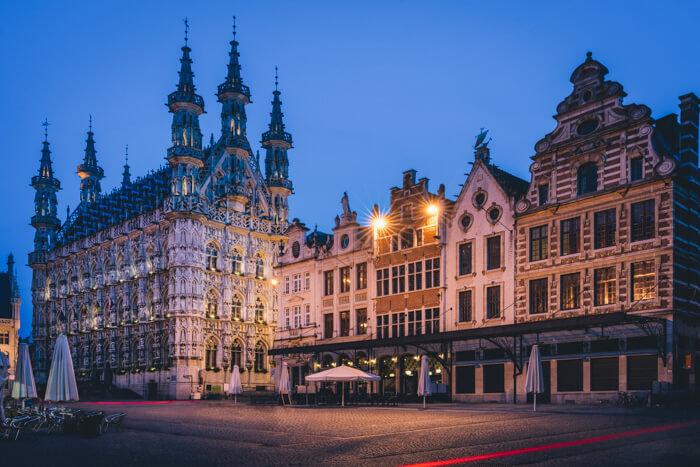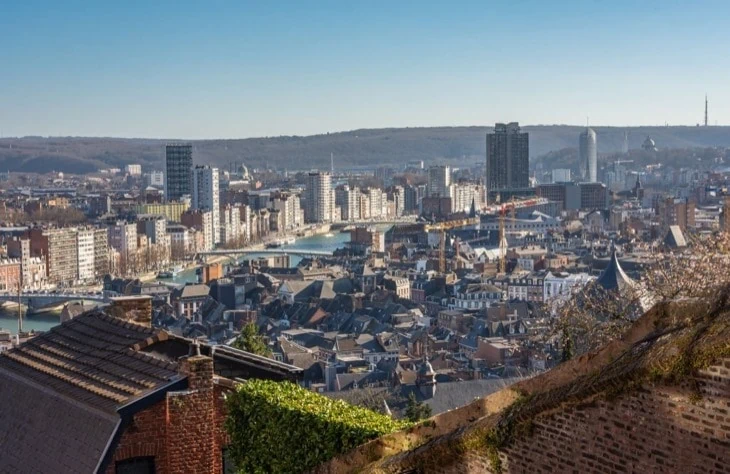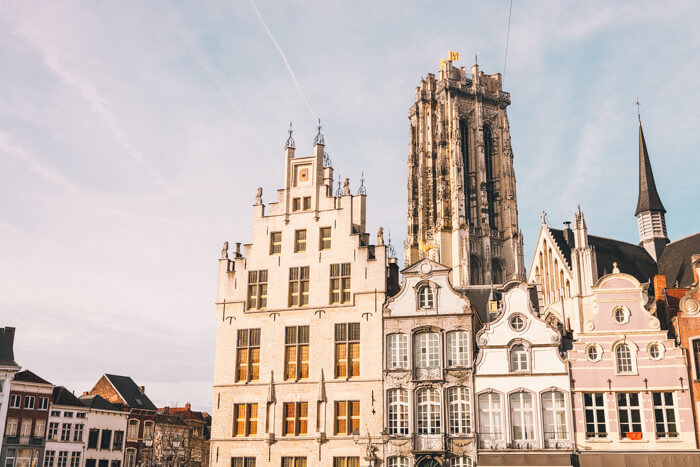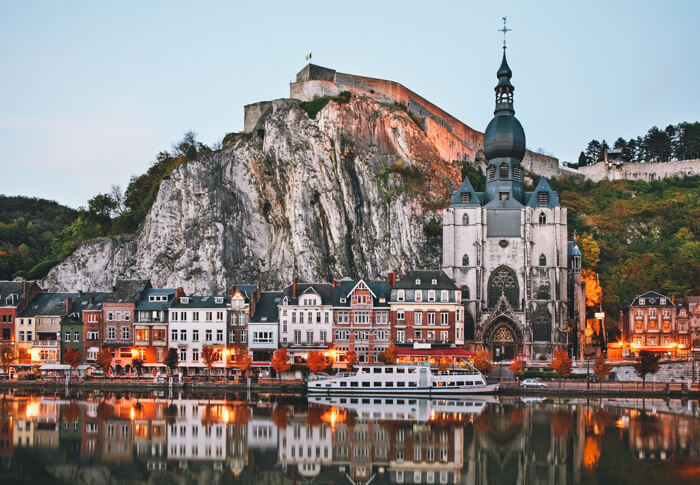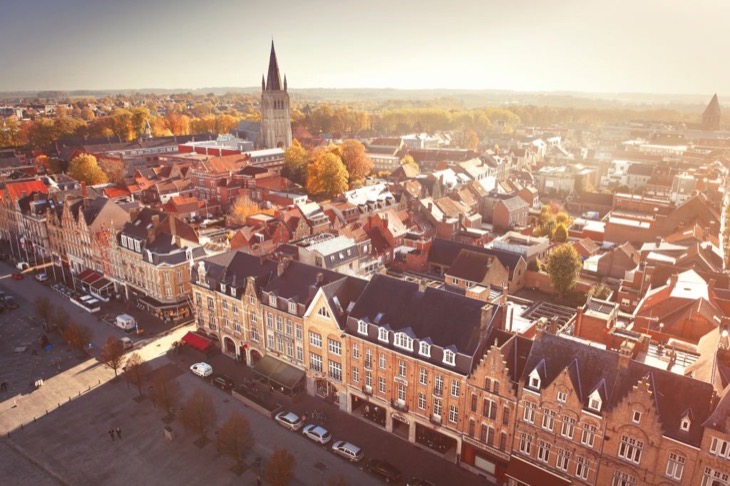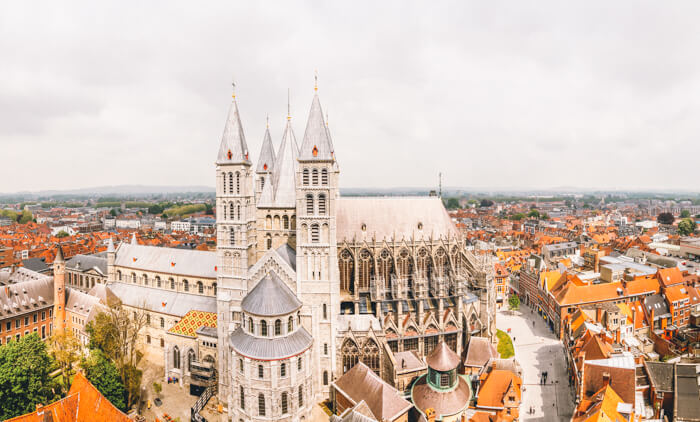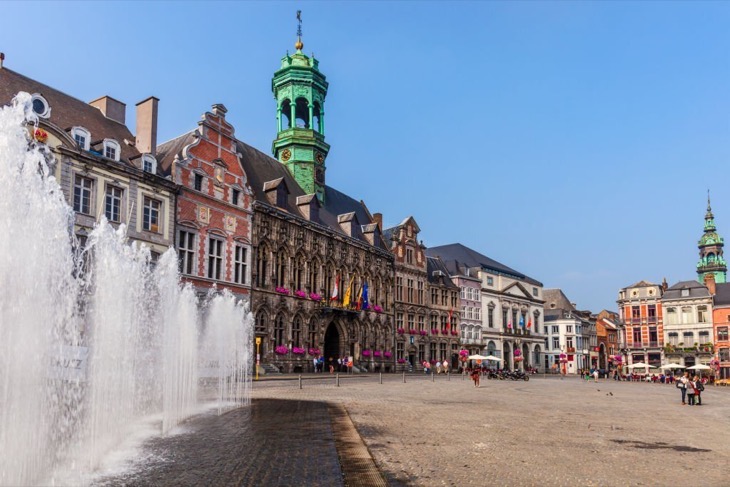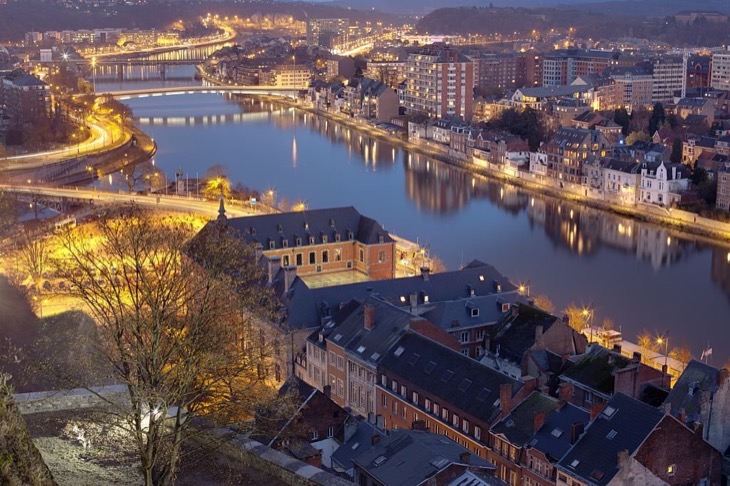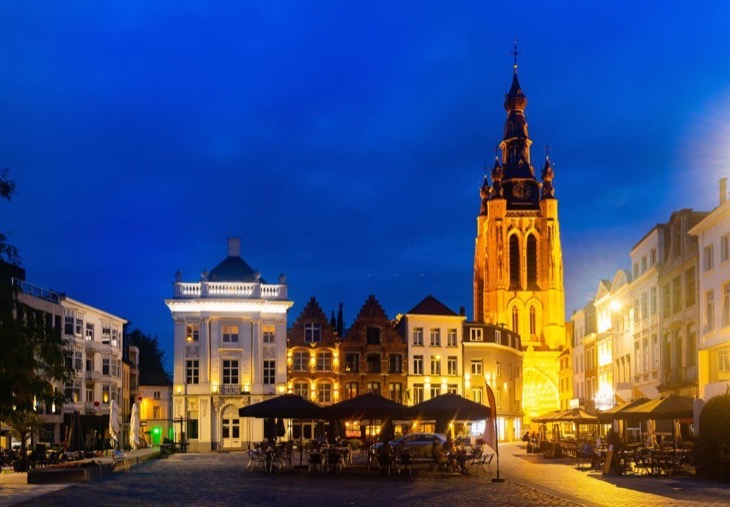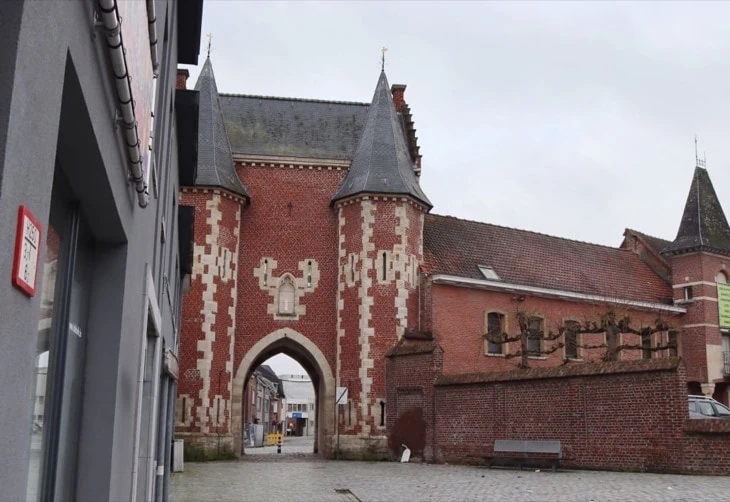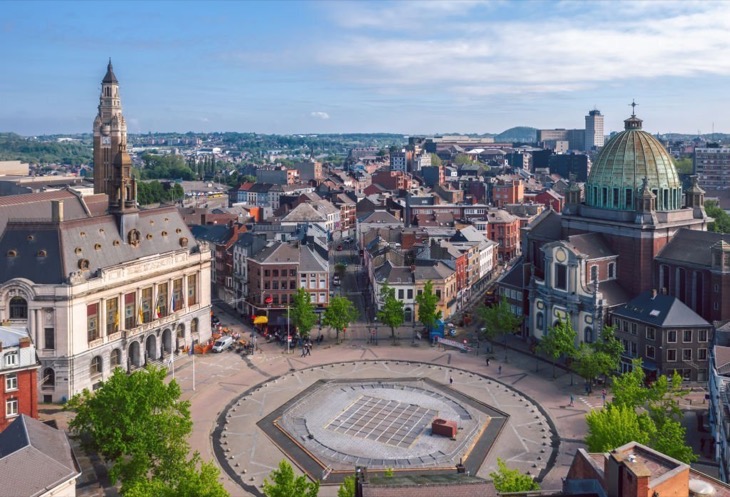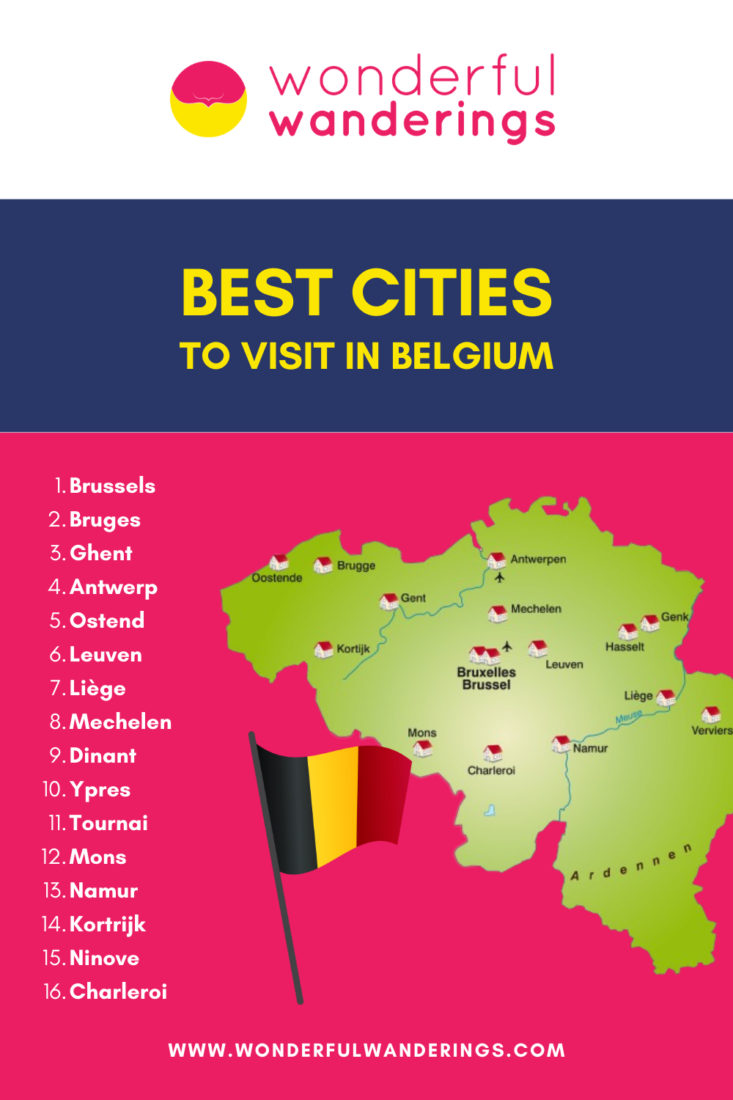So, you’re thinking of traveling to Belgium – fantastic! You probably have a pretty concrete image in your head of what you imagine the country to look like. Meandering canals, medieval city squares, grand gothic mansions and medieval cathedrals is what you’ll find in the best cities in Belgium. Not to mention the waffles and beer!
The country is split roughly across the middle by Flanders in the north (the Flemish-speaking part) and Wallonia in the south (where people speak French and, in a small region, German).
Listed below are the best cities in Belgium.
- Brussels. Brussels is the capital and largest city of Belgium. Brussels is known for its cosmopolitan culture, nightlife, shopping and being the headquarters of the EU.
- Bruges. Bruges is extremely well preserved medieval city with canals and stone buildings that looks like a fairytale. Bruges is definitely a historic highlight.
- Ghent. Ghent is a historic city with winding canals but also a youthful vibe due to large student population. Ghent is known as a “vegetarian capital of Europe”.
- Antwerp. Antwerp is the major port city known for fashion, trendy boutiques, clubs and bars. Antwerp is called the “diamond capital of the world”.
- Ostend. Ostend is a popular beach destination with seaside promenades, bars and cafes. Ostend is known as the “Queen of Belgian seaside resorts”.
- Leuven. Leuven is a youthful university city but with beautiful historic buildings like the late-Gothic Town Hall. Leuven is the home town of Stella Artois brewery.
- Liège. Liège is a modernizing city but with history evident in architectural pieces. Liège is known for lively nightlife.
- Mechelen. Mechelen is a characterful, lively city with historic architecture like St Rumbold’s Cathedral and street art.
- Dinant. Dinant is a picturesque town on the Meuse River known for watersports, caves and wildlife. Dinant is the birthplace of the saxophone.
- Ypres. Ypres is a historic town completely rebuilt after WW1 when original buildings were destroyed. Ypres is the center of war heritage.
- Tournai. Tournai is an ancient city with over 2000 years of history. It is home to one of Belgium’s most impressive cathedrals.
- Mons. Mons is a town with many historic buildings and medieval architecture but also known for modern and contemporary museums.
- Namur. Namur is a relaxed historic city on the Meuse River. Dominated by a large 10th century citadel fortress.
- Kortrijk. Kortrijk originated in medieval times but went through much rebuilding over centuries. Kortrijk is popular for the scenic canals.
- Ninove. Ninove is a charming town with stone buildings and cobblestone pathways. Some buildings date back to the Middle Ages.
- Charleroi. Charleroi, in Belgium’s Walloon region, is known for its coal mining history, earning its nickname “Black Country”. Though not a top tourist spot, it is a historically an industrial hub. Charleroi evolved into a center for tech, aeronautics and healthcare.
Contents
- 1. Brussels
- 2. Bruges
- 3. Ghent
- 4. Antwerp
- 5. Ostend
- 6. Leuven
- 7. Liège
- 8. Mechelen
- 9. Dinant
- 10. Ypres
- 11. Tournai
- 12. Mons
- 13. Namur
- 14. Kortrijk
- 15. Ninove
- 16. Charleroi
1. Brussels
Brussels is the capital city of Belgium and the administrative centre of the European Union. Brussels’ population is around 1.2 million people. Is is a major European city and has several nicknames including ‘The Capital of Europe’, the ‘Crossroads of Europe’ and ‘The Heart of Europe’. The two main languages spoken in Brussels are French and Dutch, reflecting the city’s location on the border between Belgium’s French-speaking south and Dutch-speaking north.
Brussels has a rich history and is known for its beautiful architectural landmarks. The most famous sight is the stunning Grand Place, a UNESCO World Heritage site featuring ornate guildhalls and impressive architecture. The iconic Atomium and Manneken Pis statue are other famous landmarks in the city. Brussels is also known for being the home of Art Nouveau, exemplified in architectural gems like the Horta House designed by Victor Horta. Belgian food specialties like waffles, chocolate, fries and beer are another thing Brussels is renowned for. With over 80 museums, Brussels has a thriving arts and culture scene.
Brussels is absolutely worth visiting for any visitor to Europe. Its history, architecture, culture and food make it an exciting and diverse destination. For first-time visitors, must-see places include the Grand Place, the Atomium, Manneken Pis, museums, the European Quarter and sampling waffles and chocolate. With so many attractions, beautiful sights and a welcoming atmosphere, experiencing Brussels should be on every traveller’s wishlist. Spending two days in Brussels allows visitors to experience the essence of this charming, historic and tasty European capital.
2. Bruges
Bruges is a city located in the Flemish region of Belgium. It is nicknamed the “Venice of the North” due to its picturesque canals. Bruges has a total area of 140 square kilometers and a population of around 118,000 people. The main language spoken in Bruges is Dutch.
Bruges is a very popular tourist destination, receiving about 8 million visitors per year. It is known for its well-preserved medieval architecture and historic city center, which became a UNESCO World Heritage Site in 2000. Some of the top attractions and landmarks in Bruges include the Belfry tower, the Church of Our Lady, the Lake of Love, the Begijnhof and the historic Market Square.
Bruges has many museums showcasing great works of medieval Flemish art, such as the Groeningemuseum. The city is also known for making lace, delicious chocolate and beers like Brugse Zot. Visitors can take boat tours along the scenic canals, ride in a horse-drawn carriage or climb the bell tower for panoramic views. Food lovers can indulge in Belgian waffles, fries, mussels and beer. Bruges provides a fairy tale-like experience with its cobblestone streets, gothic buildings and swans floating down the canals.
In summary, Bruges is a medieval city in Belgium with outstanding historical architecture that attracts millions of visitors each year. Nicknamed the “Venice of the North”, Bruges offers many attractions like museums, churches and boat tours along picturesque canals. With its romantic ambiance, Bruges is absolutely worth visiting for any traveler interested in experiencing the charm of this well-preserved historic city.
3. Ghent
Ghent is a historic city located in the Flemish region of Belgium. Ghent’s population is around 265,000 and it is one of the largest cities in Belgium. Ghent is sometimes referred to as (yeah, as Brugge) “The Venice of the North” due to the many canals and waterways that flow through the city. The main language spoken in Ghent is Dutch.
Ghent is a very popular tourist destination, especially for people interested in medieval architecture and art. The city has many well-preserved medieval buildings, such as the 12th century Gravensteen Castle, Saint Bavo’s Cathedral where the famous Ghent Altarpiece is displayed and the 14th century Belfry of Ghent. Ghent is also known for its museums like the Museum of Fine Arts which has an excellent collection of Belgian artwork.
In addition to the many historic sites, Ghent offers picturesque waterways and views. Visitors can take boat tours on the canals or stroll along the Graslei, a scenic row of guildhalls along the Leie river. The city center is largely car-free which makes wandering around on foot enjoyable. Ghent has a lively food scene with many restaurants, cafes and chocolate shops. Local specialities include Ghent waffles, cuberdon candies and Ghent mustard.
With its small town charm, medieval allure and modern buzz, Ghent offers an appealing blend of history, art and livability. Its compact historic center can be explored in 1-2 days making it an ideal weekend getaway. For travelers looking to experience medieval Flanders in an accessible way, Ghent is an excellent choice worth visiting.
4. Antwerp
Antwerp definitely wins the competition for being the coolest of the cities to visit in Belgium. With its hip nightlife and thriving fashion scene, this port city pulls in an eclectic mix of people.
It has a hipster food scene with plenty of craft breweries, cool restaurants, cozy coffee bars and experimental chocolatiers. There are plenty of things to do in Antwerp all-year-round as well.
It’s not the most beautiful city of Belgium because it was heavily bombed during World War 2. However, there are some wonderful sites to visit such as the 14th-century Cathedral of Our Lady, the Gothic and Baroque features of Saint Paul’s Church, the stunning street of Cogels Osylei, the Grote Markt and the spectacular central train station itself.
Antwerp is the second-largest city in Belgium and also known as Diamond City because of its roaring diamond trade. Over 70% of all the diamonds in the world are sold here.
Art and fashion have a large legacy in this town, with the MoMu Fashion Museum and star-studded Antwerp Fashion Academy. You can’t go far here without hearing the name of the legendary painter Rubens, who continues to be ever-present throughout the city even now, over 400 years after his birth.
Make sure to check out some of Antwerp’s amazing museums (including Rubens’ own house) – there are loads!
5. Ostend
Ostend is a coastal city located in the province of West Flanders in Belgium. Ostend’s population is around 70,000 people and it is Belgium’s largest coastal city. Ostend’s nickname is “Queen of the Belgian coastal cities”. Ostend is a popular beach destination and North Sea port city. The main language spoken in Ostend is Dutch.
Ostend has a significant tourism industry, attracting both inland Belgians and international visitors. Ostend is known for its sandy beaches, seaside promenade and Belle Époque architecture. Ostend’s key landmarks and monuments include the 19th century Church of Saint Peter and Saint Paul, the contemporary art museum Mu.ZEE and the Mercator, a historic three-masted sailing ship. The wide beach lined with cafes and the lively seaside promenade are popular highlights for visitors.
Ostend also has an interesting history and was heavily bombed in both World Wars due to its strategic position. Traces of the World Wars can still be seen at the open-air Atlantikwall Raversyde museum. The atmospheric old town, marina and fishing harbour offer plenty to see.
Visiting Ostend is worthwhile for those looking to experience Belgian coastal culture. It provides an easily accessible beach escape from cities like Brussels, as well as a convenient ferry crossing point to Britain. Foodies can indulge in the local seafood, especially the Ostend shrimp croquettes. With its seaside attractions, historic landmarks and local charm, Ostend offers an engaging Belgian travel experience.
6. Leuven
Leuven is a city located about 25 kilometers east of Brussels in Belgium. It is the capital of the province of Flemish Brabant. Leuven is also known by its French name Louvain. As of 2021, Leuven had a population of over 101,000 people within an area of 57.5 square kilometers. The main language spoken in Leuven is Dutch, since it is in the Flemish region of Belgium. However, many residents also speak French, English and German.
Leuven is quite touristic, especially as it is home to the Katholieke Universiteit Leuven, the largest university in Belgium. With over 45,000 students, Leuven has a vibrant, youthful atmosphere. It is considered Belgium’s oldest university town, since the university dates back to 1425. The city’s historic center is known for its beautiful architecture, including the 15th century Town Hall and the UNESCO-listed Groot Begijnhof beguinage.
Leuven is also known as a beer capital, as it is the home of large breweries like Anheuser-Busch InBev and Stella Artois. Other attractions in Leuven include the centuries-old University Library, the M-Museum Leuven and lively markets and shopping districts. Leuven makes a great day trip from Brussels to experience Belgian culture, history, beers and student life. Visitors can tour landmarks like the Town Hall, St. Peter’s Church, wander through the picturesque city center, sample beers and soak up the lively ambience. Leuven is certainly worth a visit, especially for those seeking an authentic Belgian experience off the main tourist track.
7. Liège
Liège is a major city and municipality located in eastern Belgium. Liège is located in the valley of the Meuse River and is the capital of Liège Province. Liège’s nickname is “La Cité Ardente” which means “The Fervent City” in French. Liège has a population of around 195,000 residents within the city limits. The greater metro area of Liège has the population is approximately 750,000 people. The primary language spoken in Liège is French, as it is located in Wallonia, the French-speaking region of Belgium. However, some German and Dutch are also spoken.
Liège is a popular tourist destination. It has a historic city center with medieval churches, charming squares and museums. The city is known for its cultural attractions like the La Boverie Museum, the Grand Curtius Museum and St. Paul’s Cathedral. The top attractions in Liège include the 374 steps of Montagne de Bueren leading up to the citadel, the Archéoforum archaeological site under Place Saint-Lambert and the modern Liège-Guillemins train station designed by Santiago Calatrava.
Liège has a reputation for excellent food and a vibrant nightlife scene. It is considered the culinary capital of Wallonia. The city is also known as an early center of coal mining and steel production during the industrial revolution. Today, Liège remains the economic capital of French-speaking Belgium.
Liège is a historic, culturally-rich city with impressive architecture, museums, cuisine and nightlife. Its strategic location makes it a popular tourist destination. Visitors to Liege can appreciate both the modern amenities and ancient sights of this fervent Belgian city.
8. Mechelen
Mechelen is a city in the Flemish region of Belgium. It is located between Antwerp and Brussels. Mechelen has a population of around 86,000 people. The inhabitants of Mechelen have an alternative nickname, “Maneblussers”, which means “moon extinguishers”. This name originated from a story when locals thought the moonlight shining on the cathedral tower was a fire, so they rushed to extinguish it.
The main language spoken in Mechelen is Dutch. As a historic city with many attractions, Mechelen is quite popular among tourists. The city is known for its proud architecture, churches and historical buildings. Some of the top sights to visit in Mechelen include St. Rumbold’s Cathedral, the Grote Markt central square and the two Beguinages, which are historic self-sufficient housing communities dating back to the Middle Ages.
Other highlights are the City Hall, the Skywalk at the top of St. Rumbold’s Tower offering panoramic views and landmarks like the Haverwerf port area and the palaces of Margaret of Austria and Margaret of York. Mechelen also has great museums, green spaces and the historic Het Anker Brewery to explore. Given its central location, wealth of sights and ease of access by train, Mechelen is certainly worth a visit, whether just for a day trip or a longer stay.
9. Dinant
Dinant is a picturesque city located in southern Belgium along the River Meuse. With a population of around 13,500, Dinant is a small but charming destination in Belgium’s French-speaking Wallonia region. Nicknamed “Daughter of the Meuse”, Dinant spreads along the riverbanks with colorful houses pressed against sheer cliffs. French is spoken in Dinant as it is part of Wallonia.
Dinant is a popular tourist destination thanks to its fairytale-like landscapes and historic attractions. Dinant is most famous for being the birthplace of Adolphe Sax, inventor of the saxophone. Reminders of Sax are found throughout the city in the form of saxophone sculptures, beers and a Saxophone Museum.
Other top attractions include the impressive 13th century Collegiate Church of Our Lady with its onion-domed tower and the cliffside Citadel fortress dating from the 11th century that looms over Dinant. The Meuse River itself offers scenic strolls, boat tours and outdoor adventures. Dinant’s picturesque old town charms visitors with its riverside cafes, artisanal shops and winding cobblestone streets.
For such a small city, Dinant packs in quite a bit of history, culture and natural beauty. Its convenient location near Brussels, Luxembourg and Namur makes it an easy and rewarding day trip. Travelers short on time could see Dinant’s top sights in a few hours. But the fairytale setting invites longer stays to unwind along the Meuse. With its postcard-perfect landscapes and wealth of sights, Dinant is absolutely worth a visit for any first-time traveler to Belgium.
10. Ypres
Ypres is a city in the Belgian province of West Flanders. It is officially known by its Dutch name Ieper, but British soldiers nicknamed it “Wipers” during World War I. Ypres has about 35,000 inhabitants and covers an area of 131 square kilometers. The local language is Dutch, though some people also speak French.
Ypres is a popular tourist destination due to its World War I history and Gothic architecture. It was at the center of the Ypres Salient on the Western Front and was nearly destroyed during the war. The city was rebuilt in the 1920s and 30s. Key landmarks include the Menin Gate memorial and the In Flanders Fields Museum located in the historic Cloth Hall. The daily Last Post ceremony at the Menin Gate is a moving tribute to fallen soldiers.
Other notable sites are the Gothic Saint Martin’s Cathedral, the medieval ramparts and fortifications built by Vauban, Saint George’s Memorial Church and the extensive cemeteries and memorials honoring British, Canadian and ANZAC forces. Ypres is an excellent base to visit the battlefields and trenches of Passchendaele, Polygon Wood, Hill 60 and other important sites of the war.
For history buffs interested in World War I, Ypres is a must-see destination in Belgium. The reconstructed old town center also appeals to lovers of medieval architecture and Flemish culture. Ypres offers a variety of accommodations, restaurants and shopping. While it draws many visitors for its war history, the city has rebranded itself as a “city of peace”.
11. Tournai
Tournai is a city in southwestern Belgium located near the France border. It has a population of around 69,000 people and covers an area of roughly 215 square kilometers. Also known by its Flemish name Doornik, Tournai is located in Wallonia, the French-speaking region of Belgium. The main language spoken in Tournai is French.
Tournai has over 2,000 years of history, making it one of the oldest cities in Belgium. It was an important city in Medieval times and has many historic buildings and landmarks. Two of its most famous attractions are the Notre Dame Cathedral and the Belfry of Tournai, both designated as UNESCO World Heritage Sites. The towering Notre Dame Cathedral dates back to the 12th century and features a mix of Romanesque and Gothic architecture. The Belfry, built between the 12th and 14th centuries, is the oldest belfry in Belgium and offers panoramic views from the top.
Other notable landmarks in Tournai include the Grand Place town square, the 13th century Pont des Trous bridge over the Scheldt River and several museums covering art, history and folklore. Tournai attracts many tourists interested in its history, architecture and art. It offers walking tours, boat tours along the Scheldt River and festivals throughout the year. The city is also known for its local cuisine, beers and folklore traditions.
Tournai is certainly worth visiting for travelers interested in Belgian heritage and architecture. Tournai provides an intimate alternative to the larger, more touristy cities in Belgium and northern France. Visitors can easily spend a day or two exploring the sights, relaxing at local cafes and soaking up the historic atmosphere.
12. Mons
Mons is a city located in the Wallonia region of Belgium. It is the capital of the province of Hainaut. Mons also goes by the nickname Bergen, which is the Dutch name for the city. Mons has a total area of about 148 square kilometers (57 square miles) and a population of over 95,000 people as of 2018. The main language spoken in Mons is French, since it is located in the French-speaking region of Wallonia.
Mons is quite a touristic city, known for its history, architecture and cultural sites. Some of the top attractions in Mons include the Grand Place, the central square surrounded by historic buildings like the Gothic city hall. The 17th century belfry tower is also iconic monument, described by Victor Hugo as looking like a “coffeepot flanked by four smaller teapots”. Other landmarks are the Saint Waltrude Collegiate Church, the Mons Memorial Museum and the Museum François Duesberg, with its collection of rare decorative art objects. Mons was named a European Capital of Culture in 2015.
Visitors can also see the house where Vincent Van Gogh lived for a time when he was starting out as an artist in the late 1800s. Outside the city, tourists can visit the Neolithic Flint Mines at Spiennes, which are among the earliest and largest ancient flint mines in Europe. The Doudou festival held annually in Mons is a popular cultural event. Visiting Mons offers a nice combination of historical sites, architecture, museums and local culture for visitors interested in Belgian destinations beyond Brussels. Its selection as a European Capital of Culture shows it is a city with unique cultural heritage worth experiencing.
13. Namur
Namur is the capital city of Wallonia, the French-speaking region of Belgium. It is located at the confluence of the Sambre and Meuse rivers. Namur has a nickname of “the ant-hill of Europe” given by Napoleon due to its strategic position and extensive fortifications. The city has a population of around 110,000 inhabitants within an area of 175.93 square kilometers. French is the main language spoken in Namur.
Namur is a popular tourist destination with many historical monuments and landmarks to visit. The most notable attraction is the Citadel of Namur, a mighty fortress that sits atop a rocky spur overlooking the city. Other highlights include Saint Aubin’s Cathedral, the 18th century cathedral with a distinctive domed roof and the Church of Saint-Loup, a beautiful baroque church. The pedestrianized streets of the old town are lined with shops, cafes and restaurants.
Namur is known for its slow, relaxed pace of life compared to other Belgian cities. The snail is used as a symbol of the city. Namur is also renowned for its local cuisine including puff pastries stuffed with snails and strawberries from the surrounding region. For visitors interested in history, architecture and laid-back sightseeing, Namur is certainly worth a visit. Its small size makes it ideal for leisurely strolls to take in the sights. Namur offers an appealing Belgian city break due to its historic charm and excellent food and drinking activities.
14. Kortrijk
Kortrijk is a city located in the Flemish province of West Flanders, Belgium. It is also known as Courtrai in French. With a population of around 75,000 people within the city limits, Kortrijk is one of the biggest cities in southern West Flanders. The main language spoken in Kortrijk is Dutch.
Kortrijk is considered quite touristic as it has many monuments, landmarks, museums and historic sites that attract visitors. The city is known for its important role in medieval times as a center for the flax and linen industry. It is also famous for the Battle of the Golden Spurs that took place just outside the city in 1302, a battle that holds great significance for Flemish national identity.
Some of the top attractions and monuments to see in Kortrijk include the Belfry tower, the medieval Broel Towers, Saint Martin’s Church, the scenic Begijnhof (beguinage) and Kortrijk’s Gothic-style City Hall on the main square. The museum Kortrijk 1302 provides an interactive multimedia experience detailing the famous Battle of the Golden Spurs. The museum Texture highlights the history of flax and the linen industry in the city.
Kortrijk offers much for visitors to explore and discover. The pedestrian-friendly historic city center lined with cafes and restaurants is enjoyable to stroll through. Kortrijk’s reputation as a shopping destination, with stores on traffic-free shopping streets, also helps make it an attractive place to visit. Kortrijk is certainly worth visiting for those wishing to explore Flemish culture, history and architecture.
15. Ninove
Ninove is a city and municipality located in the Flemish province of East Flanders in Belgium. It sits on the river Dender and is part of the Denderstreek region. Ninove has several nicknames including “Wortelmannen” meaning carrot people and “De Oudste, de Stoutste en de Wijste der Steden” meaning the Oldest, the Boldest and the Wisest of Cities. As of 2023, Ninove has a population of around 40,000 residents and covers an area of 73 km2, giving it a population density of 553 inhabitants per km2. The main language spoken is Dutch. While not a major tourist destination, Ninove does have some landmarks and attractions that make it worth a visit. The main sites include the Onze-Lieve-Vrouw-Hemelvaartkerk, a large cathedral and the largest in the region, the Koepoort, a medieval city gate and the Old City Hall. Ninove also has several nature areas like the Neigembos forest that are good for walks and relaxing. Additionally, Ninove hosts an annual Volkswagen show focused on air-cooled models which draws enthusiasts from across Europe. For those interested in history, architecture, nature or Volkswagen cars, Ninove has enough to make it an enjoyable side visit when travelling through Belgium. However, it is not a must-see destination comparable to Bruges, Brussels or Ghent.
16. Charleroi
Charleroi is an industrial city located in the Walloon region of Belgium, about 60km south of Brussels. It is the third largest municipality and fifth largest city in Belgium, with around 200,000 inhabitants. Charleroi is sometimes referred to as the “Black Country” due to its history of coal mining and heavy industry which left much of the landscape dotted with spoil tips and old industrial buildings. The main language spoken in Charleroi is French.
While not considered one of Belgium’s main tourist destinations, Charleroi does have some interesting attractions worth visiting. Key landmarks include the Museum of Photography, one of the largest photography museums in Europe and the Bois du Cazier, a former coal mine turned museum that is a UNESCO World Heritage Site. The city also has some Art Nouveau and Art Deco architecture, such as the ornate town hall.
Charleroi is known historically for its coal mining and steel industry, which boomed in the 19th and early 20th centuries but declined after World War II. More recently it has redeveloped into a hub for high tech industries, engineering, aeronautics and healthcare. It is home to a major airport serving low cost carriers. Charleroi has also played an important role in the history of the Belgian comic strip, being the birthplace of the famous Spirou magazine.
While some Belgians look down on Charleroi as polluted and derelict, it has cleaned up its image in recent decades. With cheap flights, interesting industrial heritage and a growing arts scene, Charleroi is worth considering as a tourist destination in Belgium beyond the more well known cities.
What is the most touristic city in Belgium?
Bruges is the most touristic city of Belgium. Bruges welcomes 8 million visitors per year, with the majority coming during the summer months and Christmas. The city’s status as a UNESCO World Heritage site, presence of notable attractions like the Belfry tower, and proximity to the port city of Zeebrugge have all contributed to its popularity among tourists.Wwhile Bruges remains a top attraction, the city is actively working to strike a balance between retaining its charm and history while preventing the excesses of overtourism that have plagued other European destinations. Its continued popularity speaks to Bruges’s enduring draw as a quintessential medieval European city.
Why do tourists visit Belgium?
Belgium is a popular tourist destination in Europe for its historic medieval towns, unique architecture, renowned art museums, multicultural cuisine and world-famous beers. Tourists massively visit the charming towns like Bruges and Ghent to admire their well-preserved medieval buildings, picturesque canals and cobblestone streets. Bruges boasts 13th century belfries, winding canals, and ornate churches that transport visitors back to medieval times. Ghent charms with its beguinages, belfries, and gabled guild houses.
Art lovers are drawn to Belgium’s many museums housing works by famous Flemish masters like Rubens and Brueghel. Antwerp’s galleries showcase art from the Flemish Primitives to Belgian surrealists like Magritte. The Museum of Fine Arts in Ghent displays masterpieces like Jan van Eyck’s Adoration of the Mystic Lamb.
Foodies indulge in Belgian favorites like moules-frites, waffles piled with whipped cream and fruit, and hundreds of high-quality beers. Belgium’s long brewing tradition has spawned specialty beers like lambics, Trappist ales, and abbey beers. Chocolate shops tempt with truffles and pralines from top brands like Godiva, Neuhaus, and Leonidas.
Outdoor enthusiasts hike and bike in the hilly Ardennes region and kayak along the Lesse River. History buffs tour WWI and WWII sites near Ypres and Bastogne. The diverse country also appeals to explorers intrigued by its complex linguistic politics and role as headquarters of the EU and NATO. Belgium’s accessibility, central location, efficient transport, and variety of attractions draw over 8 million international tourists annually.
What should a tourist know before visiting Belgium?
Listed below are the most important things a tourist should know before visiting Belgium.
- Language: Belgium has three official languages: Dutch, French and German. While English is widely spoken, especially in tourist areas, it’s always helpful to learn a few basic phrases in the local language.
- Currency: The currency used in Belgium is the Euro (€). It’s advisable to have some cash on hand, as not all places may accept credit cards, especially in smaller towns or for smaller purchases.
- Weather: Belgium has a temperate maritime climate, which means it can be quite unpredictable. It’s a good idea to pack layers and be prepared for changing weather conditions, even during the summer months.
- Transportation: Belgium has an efficient public transportation system, including trains, trams and buses. It’s recommended to use public transport to get around, as parking can be limited and expensive in cities.
- Tipping: Tipping is not mandatory in Belgium, as a service charge is often included in the bill. However, it’s customary to round up the bill or leave a small tip as a gesture of appreciation for good service.
- Opening Hours: Many shops and businesses in Belgium close on Sundays, so it’s important to plan accordingly. Additionally, some museums and attractions may have specific closing days or limited hours, so it’s advisable to check their schedules in advance.
- Safety: Belgium is generally a safe country to visit, but it’s always wise to take common precautions. Keep an eye on your belongings, especially in crowded areas and be aware of your surroundings.
These are just a few key things to know before visiting Belgium. It’s always a good idea to do some research and plan ahead to make the most of your trip.
What are the best things to do in Belgium?
Listed below find the best things to do in Belgium:
- Taste a Waffle: Belgium is renowned for its waffles. Notably, there’s no single “Belgian waffle”. Instead, there are regional varieties like Liège and Brussels waffles.
- Explore a Castle: Belgium has the highest density of castles per square kilometer. A prominent one is the Gravensteen in Ghent.
- Experience the Beer Culture: Belgium boasts between 800 to 1,000 different beers. The nation’s beer scene is so esteemed it’s a UNESCO World Heritage site. The Halve Maan in Bruges is a notable brewery.
- Visit a Beguinage: Unique to Belgium and the Netherlands, Belgium’s beguinages are UNESCO World Heritage sites. The Grand Beguinage in Leuven stands out for its serenity.
- Visit a Castle: Belgium is home to a plethora of captivating castles, each with its own unique story and architectural style. Belgium has plenty of medieval fortresses with imposing towers and elegant Renaissance residences. These castles showcase the rich history and grandeur of the country. Visiting these Castle is a journey through time.
- Commemorate the World Wars: Belgium’s history is marked by both World Wars. Tourists often visit sites like Flanders Fields and Breendonk Fortress to remember these events.
- Visit a Christmas market. The Christmas markets in Belgium are a delightful experience, filled with festive cheer and holiday spirit. Belgian Christmas markets feature small shops / stalls selling crafts and gifts to the aroma of traditional treats like waffles and glühwein.
These are just a few of the best things to do in Belgium, offering a mix of history, culture and culinary delights.
What are the best Castles in Belgium?
Listed below find the best castles in Belgium:
- Castle of Gaasbeek: Castle of Gaasbeek is located in Flemish Brabant. It is a medieval castle that offers a glimpse into the past with its rich history and stunning architecture.
- Gravensteen: Gravensteen is situated in Ghent. It is an imposing fortress dates back to the Middle Ages and provides a fascinating insight into medieval life.
- Alden Biesen Castle: Alden Biesen Castle is found in Limburg. It is known for its beautiful gardens and hosts various cultural events throughout the year.
- Groot-Bijgaarden Castle: Groot-Bijgaarden Castle is situated near Brussels and is know for its picturesque gardens and is a popular venue for weddings and events.
- Château de Beloeil: Château de Beloeil is located in Hainaut. It is considered an elegant castle is surrounded by extensive gardens and is often referred to as the “Versailles of Belgium”.
- Château de Modave: Château de Modave is nestled in the province of Liège, in a stunning hilltop location that offers panoramic views of the surrounding countryside.
- Annevoie Castle: Annevoie Castle is in Namur. It is known for its enchanting water gardens, which are considered among the most beautiful castles in Europe.
- Montaigle Castle: Montaigle Castle is found in the province of Namur. It is a captivating ruin castle that showcases the architectural splendor of the Middle Ages.
- La Roche-en-Ardenne Castle: La Roche-en-Ardenne Castle is located in the Ardennes region. This castle overlooks the town of La Roche-en-Ardenne and offers breathtaking views of the surrounding landscape.
- Château De Waroux: Château De Waroux is situated in Liège. This castle is a fine example of neoclassical architecture and is surrounded by a picturesque park.
These Belgium castles provide a fascinating glimpse into Belgium’s history and offer visitors a chance to immerse themselves in the country’s rich cultural heritage.
What are the best sweets to eat in Belgium?
Listed below find the best Belgian sweet foods for visitors to eat in Belgium:
- Belgian Chocolates: Belgium is renowned for its exquisite chocolates. Indulge in pralines, truffles and ganaches from renowned chocolatiers like Pierre Marcolini, Godiva and Leonidas.
- Speculoos: Speculoos are spiced shortcrust biscuits are a beloved Belgian treat. Enjoy them on their own or paired with a cup of coffee or tea.
- Belgian Waffles: Whether you prefer the light and crispy Brussels waffles or the denser, sweeter Liege waffles, both are delightful sweet treats. Top them with whipped cream, chocolate or fresh fruit for an extra touch of indulgence.
What are the best world war monuments to visit in Belgium?
Listed below find the best World War monuments to visit in Belgium:
- In Flanders Fields Museum: In Flanders Fields Museum is based in Ypres provides a comprehensive look at the history of World War I in the Flanders region.
- West Front Nieuwpoort: West Front Nieuwpoort is located in Nieuwpoort, this site commemorates the Battle of the Yser and offers stunning views of the Belgian battle site areas.
- Hill 62: Hill 62 is known as Sanctuary Wood. It is a Canadian memorial near Ypres, it honors the defense of Ypres by Canadian troops during the First World War.
- Lange Max Museum: Lange Max Museum is situated in Koekelare, this museum offers insights into the German side of the Western Front and is located on the site of the “Long Max” artillery piece.
- Hooge Crater Museum: Hooge Crater Museum is located near Ypres focuses on the Battle of Hooge and provides a unique perspective on the war.
Is it expensive to live in Belgium?
Yes, living in Belgium can be quite expensive. The cost of living in Belgium is influenced by various factors such as housing, transportation, food and healthcare. Housing, in particular, can be a significant expense, especially in cities like Brussels. However, it’s important to note that the cost of living can vary depending on your lifestyle and location within Belgium.
PIN FOR LATER

